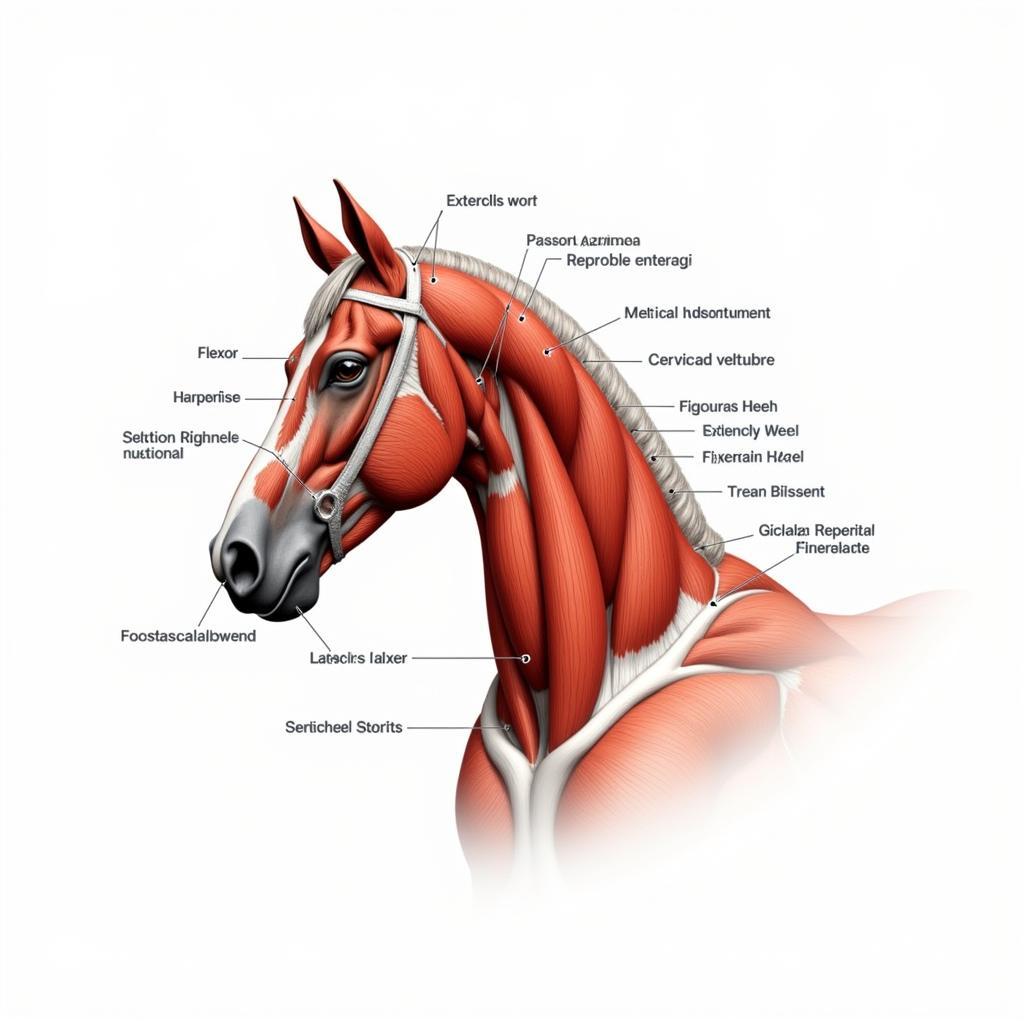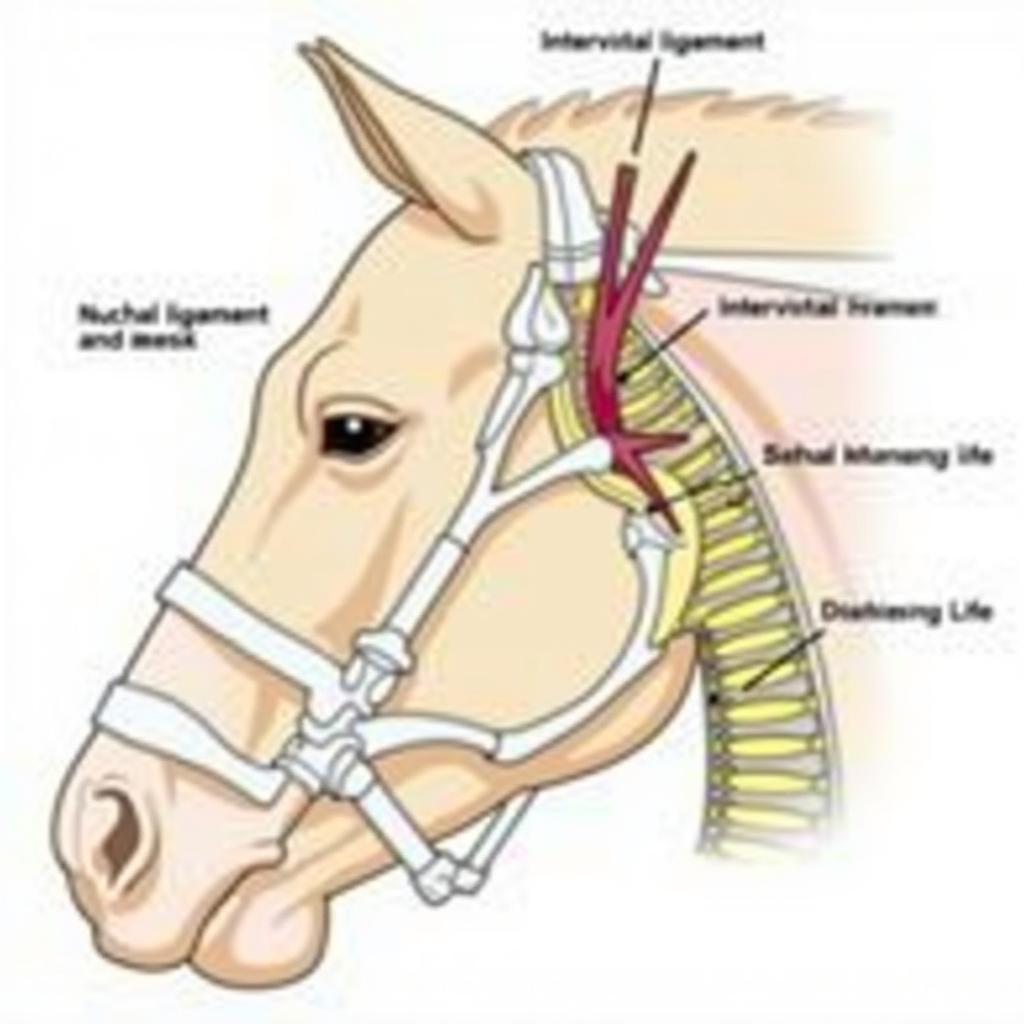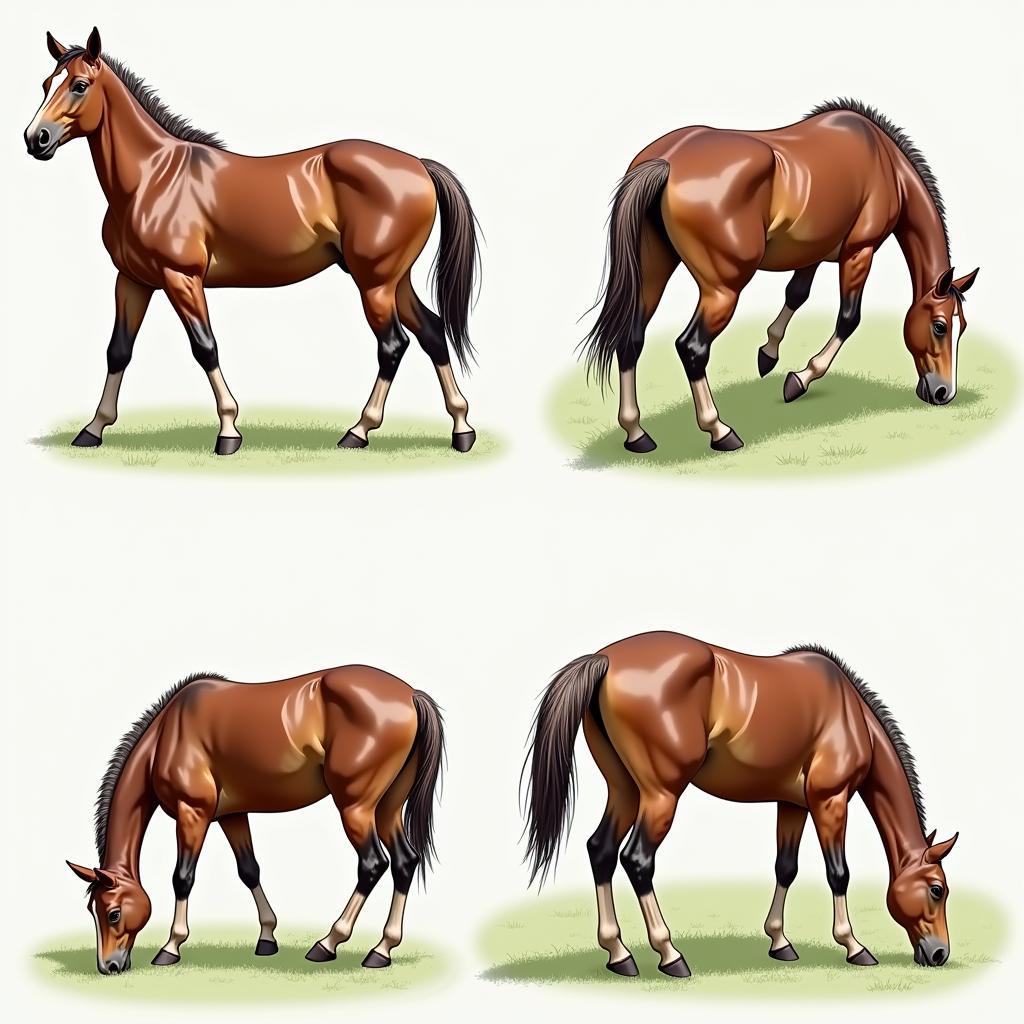The Horse Anatomy Neck is a complex and fascinating structure, crucial for balance, movement, and communication. Understanding its intricacies is essential for any horse owner or enthusiast. This article will delve into the anatomy of the horse’s neck, exploring its muscles, bones, and ligaments, and explaining how they work together to enable the horse’s remarkable athleticism.
The horse’s neck is much more than just a connection between the head and the body. It plays a vital role in everything from grazing to jumping, influencing the horse’s posture, balance, and overall performance. Let’s explore this remarkable structure in detail.
The Skeletal Framework: Cervical Vertebrae
The foundation of the horse’s neck is the cervical spine, composed of seven cervical vertebrae. These vertebrae, numbered C1 to C7, provide structural support and flexibility. The first two vertebrae, the atlas (C1) and the axis (C2), are uniquely shaped to allow for a wide range of head movement. The atlas connects directly to the skull, enabling nodding motions, while the axis facilitates rotation. The remaining five vertebrae are more uniform in structure, providing stability and allowing for lateral flexion.
The connection between each vertebra is crucial. Intervertebral discs, made of cartilage, act as shock absorbers and allow for smooth movement. These discs are prone to wear and tear, especially in older horses or those engaged in strenuous activities.
You can learn more about how the horse’s neck relates to its overall balance by exploring resources like bascule horse.
The Importance of C1 and C2
The atlas and axis are especially important for the horse’s ability to graze and maintain balance. The atlas’s articulation with the skull allows the horse to lower its head for grazing, while the axis enables the horse to turn its head quickly to scan its surroundings. These two vertebrae are critical for the horse’s survival in the wild.
The Powerhouse: Neck Muscles
The horse’s neck muscles are responsible for a wide range of movements, from subtle shifts in head position to powerful extensions during running and jumping. These muscles can be broadly categorized into extensors, flexors, and lateral flexors.
The extensor muscles, located along the top of the neck, lift the head and neck. The brachiocephalicus, for example, extends from the head to the humerus (upper arm bone) and plays a crucial role in extending the head and neck forward.
The flexor muscles, situated underneath the neck, lower the head and neck. The sternocephalicus, originating from the sternum (breastbone) and inserting into the head, is a primary flexor muscle.
The lateral flexors, located on the sides of the neck, allow the horse to bend its neck sideways. Understanding these muscle groups is crucial for effective training and injury prevention.
 Horse Neck Muscles Anatomy Diagram
Horse Neck Muscles Anatomy Diagram
Ligaments: Holding it All Together
Ligaments are strong, fibrous tissues that connect bones to other bones. In the horse’s neck, ligaments provide stability and support to the cervical vertebrae, limiting excessive movement and preventing injury. The nuchal ligament, a prominent ligament running along the top of the neck, is particularly important for supporting the weight of the head. This ligament is essential for the horse’s posture and ability to carry its head correctly.
For more information on the external features of the horse’s neck, you can refer to resources like crest on a horse.
The Nuchal Ligament’s Role in Posture
The nuchal ligament plays a critical role in maintaining the horse’s natural head carriage. It supports the weight of the head and neck, allowing the horse to move efficiently and comfortably. A healthy nuchal ligament is essential for proper biomechanics and performance.
 Horse Neck Ligaments and Vertebrae Structure
Horse Neck Ligaments and Vertebrae Structure
Common Neck Issues in Horses
Several conditions can affect the horse’s neck, including muscle strains, arthritis, and poll evil. Understanding these conditions and their symptoms can help horse owners seek timely veterinary care. Regular veterinary checkups and proper training techniques can help prevent many neck-related problems.
Learn more about the trapezius muscle, a key muscle in the horse’s neck and shoulder area, at horse trapezius muscle. Understanding this muscle is vital for assessing and addressing potential issues in the neck and shoulder region.
Recognizing the Signs of Neck Pain
Horses experiencing neck pain may exhibit a variety of symptoms, including stiffness, reluctance to bend their neck, and difficulty with certain movements. Early detection and intervention are crucial for preventing long-term problems.
Conclusion
The horse anatomy neck is a marvel of biological engineering. Its intricate network of bones, muscles, and ligaments allows for a wide range of movement and plays a critical role in the horse’s balance, performance, and overall well-being. Understanding this complex structure is essential for any horse owner or enthusiast. By appreciating the intricacies of the horse’s neck, we can better care for these magnificent animals and appreciate their athletic prowess. For a comprehensive overview of horse anatomy, you might find a resource like printable parts of a horse helpful. And, if you’re considering a new saddle, understanding your horse’s neck anatomy is crucial for proper fit. Check out our guide on measuring a horse for a saddle for more information.
 Horse Neck Range of Motion Demonstration
Horse Neck Range of Motion Demonstration
FAQ
- How many vertebrae are in a horse’s neck? Seven.
- What is the nuchal ligament? A strong ligament that supports the weight of the horse’s head and neck.
- What are the main muscle groups in the horse’s neck? Extensors, flexors, and lateral flexors.
- What are some common neck problems in horses? Muscle strains, arthritis, and poll evil.
- How can I tell if my horse has neck pain? Look for signs of stiffness, reluctance to bend the neck, and difficulty with certain movements.
- Why is understanding horse anatomy neck important? It’s crucial for proper care, training, and recognizing potential health issues.
- What is the role of the atlas and axis vertebrae? They allow for a wide range of head movement, including nodding and rotation.
Need assistance with your horse? Contact us! Phone: 0772127271, Email: [email protected] Or visit us at: QGM2+WX2, Vị Trung, Vị Thuỷ, Hậu Giang, Việt Nam. Our customer care team is available 24/7.